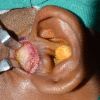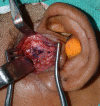Clinical and MRI Evaluation of Orthodontic Mini-Screws for Disc Repositioning in Internal Derangement of TMJ: A Prospective Study
- PMID: 29382994
- PMCID: PMC5772029
- DOI: 10.1007/s12663-017-1018-7
Clinical and MRI Evaluation of Orthodontic Mini-Screws for Disc Repositioning in Internal Derangement of TMJ: A Prospective Study
Abstract
Purpose: The purpose of this study was to assess the efficacy of orthodontic mini-screws as a modified suture anchor for disc repositioning in cases of internal derangement of the temporomandibular joint.
Patients and methods: A prospective evaluation of ten patients was undertaken for a period of 6 months using this modified approach from Jan 2014 to Jun 2016. Symptomatic patients with clinical and MRI features suggestive of internal derangement of TMJ and willing to undergo surgical repositioning of articular disc to alleviate symptoms of temporomandibular dysfunction were taken up for the study. Post-operatively, functional outcomes were assessed in terms of reduction in pain, joint movement and absence of joint noise and clicking sounds. Post-operative MRI was used to assess the disc position and morphological changes in the disc and arthritic changes in the condyle.
Results: All patients underwent a surgical repositioning of the anteriorly displaced disc by the modified orthodontic suture anchor. Patients were post-surgically followed up at intervals of 1, 3 and 6 months. Immediate complications in terms of pain, restriction of functional motion and transient facial nerve palsy were noted. Late complications include temporal nerve palsy in one case. All patients experienced significant improvement with good functional outcomes and stable repositioning of disc was noticed at the end of 6 months.
Conclusion: The modified disc repositioning using an orthodontic screw via a mini preauricular approach provided a good functional outcome in all patients as assessed over a period of 6 months. However, the long-term functional sequel of the procedure and changes in the articular disc needs to be assessed.
Keywords: Disc repositioning; Orthodontic mini-screws; TMJ internal derangement.
Conflict of interest statement
Compliance with Ethical StandardsAuthors declare that they have no conflict of interest.
Figures









Similar articles
-
Temporomandibular Joint Disc Repositioning Using an Orthopedic Suture Anchor: A Modified Disc Anchoring Technique.J Maxillofac Oral Surg. 2016 Sep;15(3):404-407. doi: 10.1007/s12663-015-0838-6. Epub 2015 Aug 19. J Maxillofac Oral Surg. 2016. PMID: 27752215 Free PMC article.
-
Arthroscopic reduction and rigid fixation of the anteriorly displaced temporomandibular joint disc without reduction using titanium screw: a case series.Clin Oral Investig. 2024 Feb 20;28(2):156. doi: 10.1007/s00784-024-05552-2. Clin Oral Investig. 2024. PMID: 38376600
-
Disc repositioning by open suturing vs. mini-screw anchor: stability analysis when combined with orthognathic surgery for hypoplastic condyles.BMC Musculoskelet Disord. 2022 Apr 26;23(1):387. doi: 10.1186/s12891-022-05337-2. BMC Musculoskelet Disord. 2022. PMID: 35473596 Free PMC article.
-
Disc repositioning: does it really work?Oral Maxillofac Surg Clin North Am. 2015 Feb;27(1):85-107. doi: 10.1016/j.coms.2014.09.007. Oral Maxillofac Surg Clin North Am. 2015. PMID: 25483446 Review.
-
Role of magnetic resonance imaging in the clinical diagnosis of the temporomandibular joint.Cells Tissues Organs. 2005;180(1):6-21. doi: 10.1159/000086194. Cells Tissues Organs. 2005. PMID: 16088129 Review.
References
-
- Cai XY, Jin JM, Yang C. Changes in disc position, disc length, and condylar height in the temporomandibular joint with anterior disc displacement: a longitudinal retrospective magnetic resonance imaging study. J Oral Maxillofac Surg. 2011;69(11):e340–e346. doi: 10.1016/j.joms.2011.02.038. - DOI - PubMed
-
- Quinn PD (1998) Surgery for internal derangements. In: Color atlas of temporomandibular joint surgery. Mosby Co., St Loius, pp 55–99
-
- Dworkin SF, LeResche L. Research diagnostic criteria for temporomandibular disorders: review, criteria, examinations and specifications, critique. J Craniomandib Disord. 1992;6:301–355. - PubMed
LinkOut - more resources
Full Text Sources
Other Literature Sources
Miscellaneous
